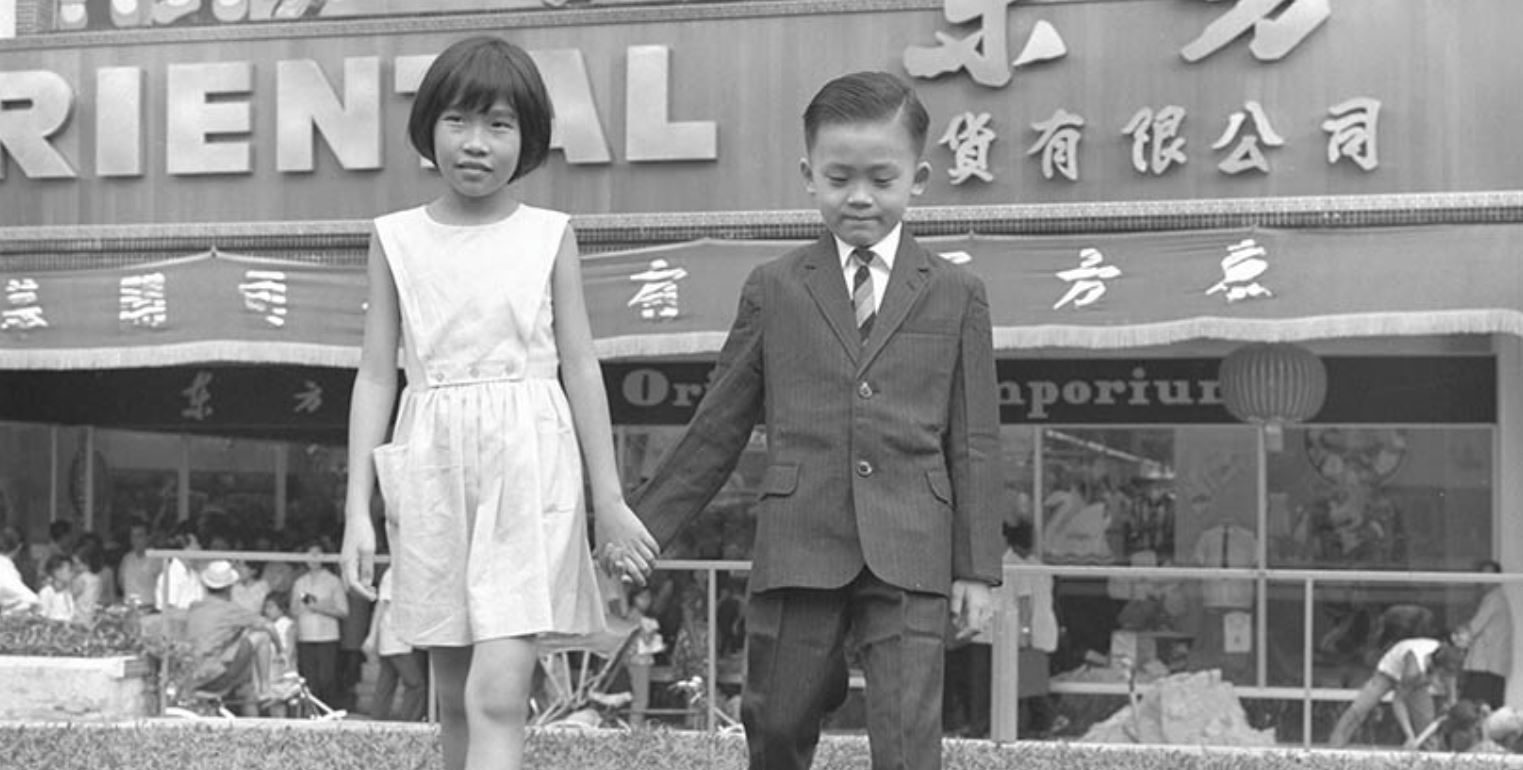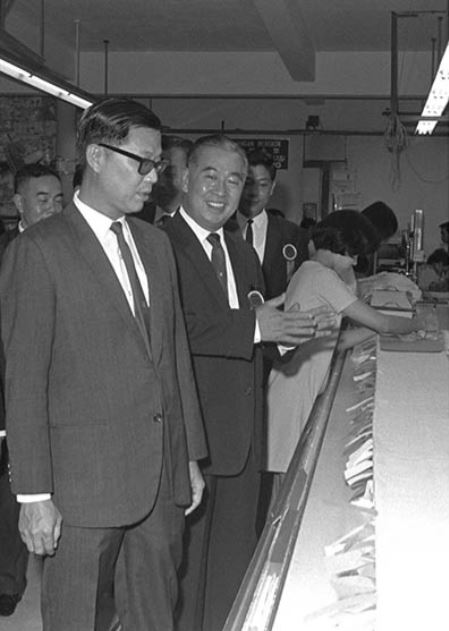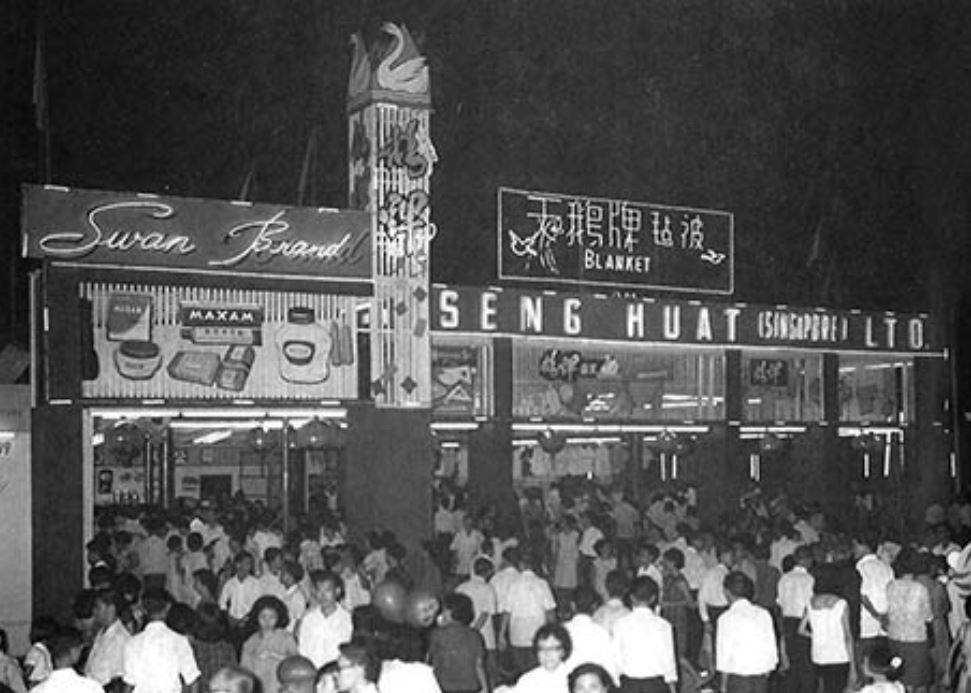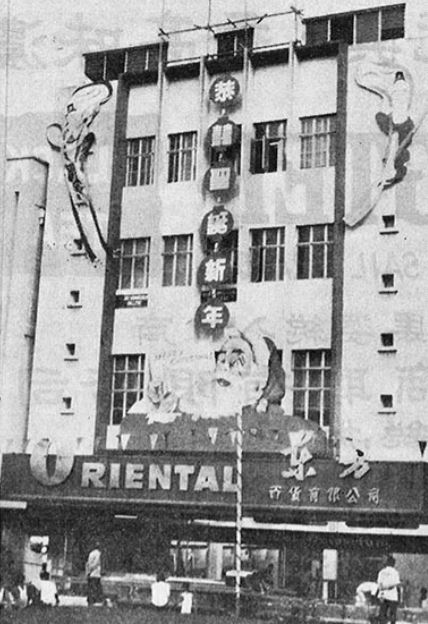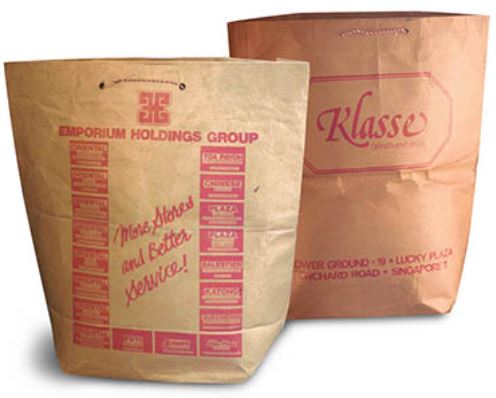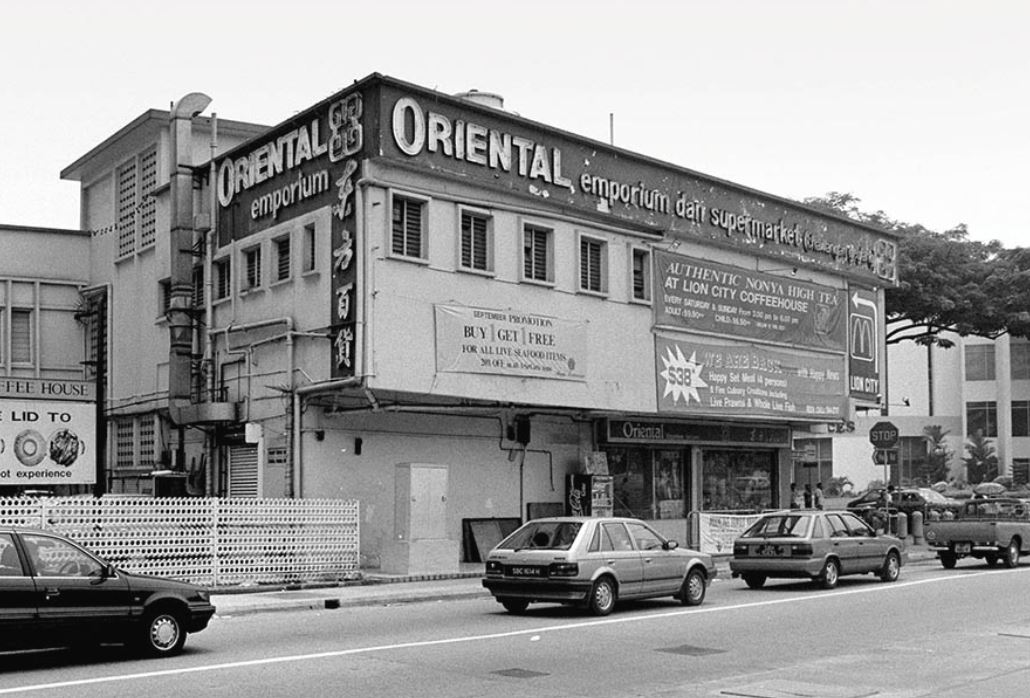Oriental Emporium: The End of an Era
The Emporium chain of department stores entered the scene when the retail market in Singapore was still in its infancy. Kam Kit Geok takes a closer look at a much-loved shopping icon.
Those who lived in Singapore from the mid-1960s to the ’80s will very likely remember shopping at the Emporium chain of Chinese-inspired department stores and supermarkets, or eating at an Oriental Restaurant – all of which were managed by the Emporium Holdings Group. Sandy Wong, who deposited her memory with the Singapore Memory Project.1 recalled happy times spent at an Oriental Emporium:
“[T]he most popular [department store in the 1980s] would be the Oriental Emporium. I remembered my aunt mentioning that they opened almost all the stores on the same day, across various locations in Singapore. We thoroughly enjoyed ourselves and… always ask[ed] for toys… Oriental Emporium… was… a favourite for many in the 1980s.”2
Many people remember Oriental Emporium as the go-to shopping destination when they were growing up. This was where they happily browsed the toys section, “[ran] up and down the staircases” or hung out with their family and loved ones after dinner.3 Some remember the department store as “a practical and affordable place to shop”.4
The first Oriental Emporium opened in Raffles Place in 1966 – the brainchild of Teochew brothers Lim Tow Seng and Lim Tow Yong, who hailed from Swatow, China. Elder brother Tow Seng came to Singapore first to work as an apprentice and saved up enough money to open his first business called Lim Seng Huat (林信发) in 1938, an import-export trading house specialising in China-made sundry goods. Tow Yong, the younger brother, joined his brother’s business in 1941.
In its heyday in the mid-1980s, Emporium Holdings5 operated more than 70 department stores, supermarkets and restaurants across Singapore, Malaysia, Brunei and Hong Kong. These were the boom years for the company, and within a span of 18 years, it grew to become one of the largest retail groups in Singapore and Malaysia.
Emporium Enters the Scene
With the closure of Whiteaways at Fullerton Square and Gian Singh on Battery Road in the early 1960s, Robinsons – which had acquired John Little in 1955 – became the sole department store still standing in Raffles Place. Shopping at Robinsons was considered a luxury at the time as the range of Western products it carried was expensive and catered mainly to the expatriate community and affluent locals.6
Mabel Martin, a stenographer, remarked that Robinsons was the place where “you had to have enough money to buy”.7 Ng Joo Kee, who used to live on Chulia Street in Raffles Place, recalled that Robinsons catered “more for expatriates, for the Eurasians and not for the locals”, and as a child, he felt rather intimidated when shopping there.8
The opening of the first Oriental Emporium in Raffles Place on 1 December 1966 was thus warmly welcomed as it provided a new and much more affordable shopping experience. The department store occupied two storeys in the former premises of Gian Singh, which was located just opposite Robinsons. In his message in the publication commemorating the opening of the department store, Chairman Lim Tow Seng said that Oriental Emporium was built to complement the government’s efforts in promoting tourism and to provide a budget-friendly alternative shopping option for the ordinary people.9
Now, for the first time, there was a department store in town that catered to both locals and tourists who were looking for reasonably priced goods. Ng Joo Kee, for one, remembers that he felt more at ease shopping at the Oriental Emporium compared to Robinsons, and that his family preferred the former as the prices were lower, and the store carried a wide variety of Chinese products.10
From the start, Emporium sourced its products mainly from China because of their reasonable prices and relatively good quality and product range. Part of the popularity of Emporium was its reputation as the first department store in Singapore to sell a wide variety of China-made products, including canned food, cotton garments, blankets, pillows, stationery, toiletries and other household items.
The shopping experience at Emporium was further enhanced by open-shelf displays, providing customers with ample space to browse and handle the products. The strategies paid off: consumers responded most enthusiastically, and Emporium raked in sales of $5 million in its first year of operations.
In January 1968, less than two years after its flagship store opened in Raffles Place, Emporium unveiled a second department store, Eastern Emporium, in the busy shopping district of High Street. The three-storey Eastern Emporium was touted by The Straits Times as a comprehensive department store selling China-made and local consumer goods.11 The store was fully air-conditioned and served by modern lifts.
In the subsequent year, Emporium acquired Chinese Emporium Private Limited at International Building on Orchard Road. This marked the company’s first foray into the Orchard Road area. This was followed by the acquisition of Yuyi Pte Ltd in 1970, a Chinese-style department store on Grange Road, just opposite Orchard Cinema.
Emporium Expands and Diversifies
In the wake of Singapore’s rapid economic growth in the 1970s, consumers became more affluent and shopping evolved from being a necessity to a lifestyle choice. With greater purchasing power and more leisure time on their hands, people had higher expectations of the quality and variety of products they could buy, and were also more willing to splurge on better-made imported goods. Emporium Holdings was quick to seize the opportunity by diversifying its retail offerings. To cater to the needs of customers from different segments of society, Emporium established a second department store chain.
Milestones
The Oriental Emporium chain would continue to sell budget-friendly China-made and local products, while a more upmarket brand was launched in 1978 with the opening of the first Klasse Department Store in Lucky Plaza. The glitzy, multi-storey Lucky Plaza mall had just opened in the heart of the Orchard Road shopping belt to much fanfare with its upmarket shops and boutiques, and a glass-clad external “bubble lift”, purportedly the first of its kind in Southeast Asia.
Klasse Department Store was well placed to capture a slice of the luxury shopping segment comprising local consumers and tourists looking for quality merchandise. It was stocked with expensive designer goods from prominent American brands (Sears, Burlington, Cannon and Samsonite) to British glassware (Pyrex) and Japanese products (三爱服装).
To align with the store’s branding, Emporium Holdings recruited staff who were bilingual and comfortable speaking languages such as English and Japanese. Gone was Emporium’s trademark Mandarin-collared uniform, which was replaced with a smart rust-coloured and beige outfit comprising an A-line skirt, waistcoat and a short-sleeved shirt.
In the meantime, the Oriental Emporium chain of department stores and supermarkets began expanding into public housing estates and new satellite towns. In 1973, it opened the first neighbourhood store in Toa Payoh – called Toa Payoh Emporium – to provide a one-stop shopping experience for residents. On the opening day, The Straits Times reported that unlike other emporiums, this one “being in a residential estate, great emphasis… [was] made to have on sale household merchandise, foodstuff, canned goods and confectionery and other products on similar lines as a supermarket”.12
Oriental Emporium stores were strategically located in high-density areas in the heart of town centres and near transport facilities in order to reach out to residents. The two-storey Toa Payoh Emporium, for instance, was situated in Toa Payoh Central, near the bus terminal and other amenities such as the stadium, two cinemas and a church.
The Straits Times reported in glowing terms that Emporium department stores had become social spaces where one could “renew old acquaintances or to strike up new friendships” and were a “welcome relief from the drudgery of routine home chores” for housewives. Shopping had become an aspirational goal “contribut[ing] immensely towards elevating the standard of living of people in a modern society.”13
Emporium Comes into its Own
There was no stopping the expansion of the Emporium Holdings Group. On 28 March 1980, it pulled a major feat by opening no less than 10 new outlets on the same day: Oriental Emporium & Supermarket in Clementi, Woodlands, Bukit Timah and Bukit Merah; Oriental Emporium in Bedok; Oriental Restaurants in Ang Mo Kio and Bedok; a Klasse Department Store and Café De Klasse in Peninsula Plaza serving Western and local cuisines; S-Mart Supermarket in Bedok; and Plaza Department Store & Supermarket in Ang Mo Kio.14
(Right) A paper carrier bag from Klasse Department Store in Lucky Plaza, 1970s. Courtesy of National Museum of Singapore, National Heritage Board.
To diversify its retail offerings to customers, Emporium extended the concept of a “one-stop shopping experience” by setting up restaurants and confectioneries within its department stores. Oriental Emporium Ang Mo Kio, for example, housed an Oriental Restaurant and the Gingerbread House confectionery. The latter sold a wide array of Western-style buns, breads and cakes and even offered islandwide deliveries, while the restaurant provided catering services for special occasions such as birthdays and weddings. One could literally shop and eat at the Oriental Emporium in Ang Mo Kio all day long without stepping out of its premises. This is nothing new in today’s retail scene of course, but back in 1980, this concept was revolutionary.
To compete with the influx of Japanese department stores, such as Isetan and Yaohan, which made inroads into Singapore in the 1970s and 80s, Emporium launched Yokoso Superstore – Singapore’s first round-the-clock supermarket and department store – in Tanjong Katong Complex in January 1983. This was a time when 24-hour stores were unheard of: the first 7-Eleven 24-hour convenience store only opened five months later in June 1983. To prepare for the opening of Yokoso Superstore, senior staff were sent to Japan to undergo training, and Japanese retail experts were also brought in. In 1985, Emporium collaborated with the Japanese again, this time with supermarket chain Kimisawa, to set up Oriental Kimisawa Superstore in Hougang.
Another first by Emporium in Singapore’s retail history was the establishment of the Small World Superstore in Parkway Parade shopping centre in December 1983. This was a three-storey children’s department store specialising in children’s merchandise and with facilities like an amusement and food arcade. It housed the American fast food restaurant Chuck E. Cheese, a photography studio, playground, children’s hair salon, mini aquarium and a performance stage.
The End of an Era
When Singapore experienced its first post-independence economic recession in 1985, Emporium Holdings took a severe hit.15 Confronted by financial difficulties on multiple fronts, the company was liquidated in 1987 and the Lim brothers who founded Emporium Holdings were declared bankrupt the following year.
The Emporium Holdings Group was acquired by various entities over the years. In the 1990s, there were sporadic newspaper reports on the Emporium brand, such as the opening of a refreshed Oriental Emporium in Ang Mo Kio in 1997.16 But with increasing competition, the brand did not survive the times, forcing Emporium to shutter the doors of all its department stores on 22 July 1999 without prior notice – more than 30 years after the first Oriental Emporium opened in Raffles Place in 1966.
Although the Emporium retail giant has exited from Singapore’s shopping scene, the company is still noteworthy for the innovative concepts it pioneered in the local retail scene. For over three decades, the Emporium chain of department stores, supermarkets and restaurants delighted scores of shoppers and customers – many of whom still have fond memories of the brand.
THE TIES THAT BIND
The story of Emporium Holdings Group would not be complete without mentioning the special bond shared by the company and its employees. When Emporium began battling rumours of financial difficulties during the 1985 economic recession, about 200 staff members organised a special lunch banquet at the Oriental Restaurant in Ang Mo Kio to show their unity and support for the management. During the lunch, staff presented the management with a signed declaration to demonstrate their confidence in the company and pledged to be more efficient in their work. Unfortunately, Emporium Holdings fell victim to the economic recession in 1987.
In September 1996, nine years after the liquidation of Emporium Holdings, ex-employees of the company organised a get-together dinner themed “Sparkling Memories” to show their appreciation for former managing director, Lim Tow Yong (Lim Tow Seng passed away in January 1992). About 800 former staff attended the dinner.
Fast forward to 2006, Lim published an advertisement in the Chinese newspaper, Lianhe Zaobao, on 17 October inviting former employees to a dinner to show his appreciation for their support over the years. A quote in the invitation card is particularly memorable: “不在乎天长地久,只在乎一起走过闪烁的日子”, which means “It matters not if it doesn’t last an eternity, what matters are the bright days that we have spent together”.17 Some 1,400 former staff attended the dinner held on 20 December 2006, and each was given a red packet containing $100.18 The strong bond and camaraderie forged between boss and staff was still palpable 20 years following the demise of Emporium Holdings.
In an interview with The Straits Times on 29 October 2006, Lim spoke about how the dinner organised by his staff in 1996 had motivated him and ignited his fighting spirit to restart the business in 1999. (Lim was then aged 75 and had just been discharged from bankruptcy).19 He said: “It [the dinner] just touched my heart and I have never forgotten it. I’ve thought about it every day for the last 10 years and I told myself that I must work hard and one day pay them back.”20 Lim passed away in April 2012.
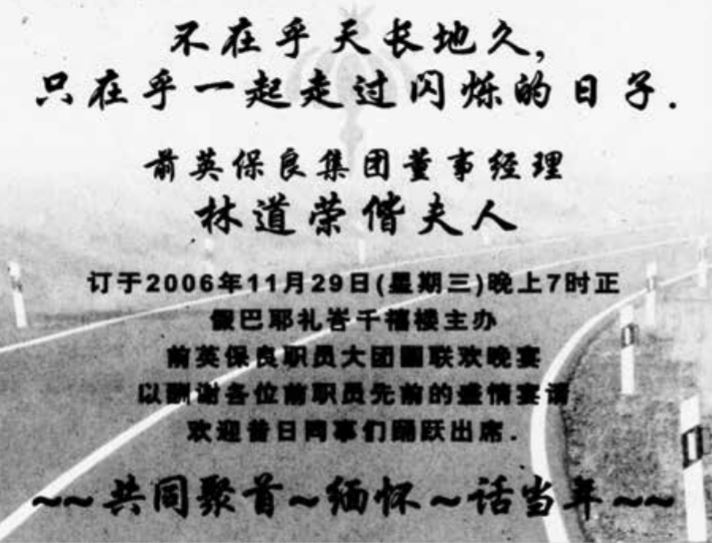
Milestones
| 1938 | Lim Tow Seng establishes Lim Seng Huat, an import-export trading house specialising in China-made sundry goods, in half of a shophouse space on Pickering Street, before moving to 13 Circular Road later. The Circular Road shophouse later becomes the head office of Emporium Holdings Group. |
| 1950s-1960s | Lim Tow Seng and his brother Lim Tow Yong participate in trade fairs at Great World and New World amusement parks to promote their products. |
| 1966 | Oriental Emporium department store opens in Raffles Place on 1 December. |
| 1968 | 1968 Eastern Emporium on High Street opens. |
| 1969 | Chinese Emporium Private Limited on Orchard Road is acquired. |
| 1970 | Yuyi Private Limited on Grange Road is acquired. |
| 1973 | Emporium Holdings Group is established and opens a number of stores: Oriental Emporium & Supermarket in People’s Park and Jurong; Katong Emporium & Supermarket, Toa Payoh Emporium; and Sin Hua Emporium at Happy World amusement park. |
| 1974 | Oriental Emporium in Balestier and Queenstown open. |
| 1977 | Oriental Emporium opens in Rochor. |
| 1978 | Klasse Lucky No. 1 in Lucky Plaza and Oriental Emporium in Ang Mo Kio open. |
| 1979 | Oriental Emporium in Raffles Place and Eastern Emporium on High Street close when their leases expired. |
| 1980 | Official opening of eight outlets and two restaurants on the same day on 28 March: Oriental Emporium & Supermarket in Clementi, Woodlands, Bukit Timah and Bukit Merah; Oriental Emporium in Bedok; S-Mart Supermarket in Bedok; Klasse Department Store and Café De Klasse in Peninsula Plaza; Plaza Department Store & Supermarket in Ang Mo Kio; and Oriental Restaurants in Ang Mo Kio and Bedok. Oriental Slasher Emporium in Hong Lim Complex; Oriental Emporium & Supermarket in Holland Village; and Oriental Restaurants in Clementi and Bukit Merah open later in the year. |
| 1981 | 15th anniversary of Emporium Holdings; opening of new head office in Ang Mo Kio; Oriental Emporium & Supermarket opens in Geylang; and Home Furnishing Centre opens in Redhill. |
| 1982 | Oriental Emporium & Supermarket opens in Serangoon. |
| 1983 | Klasse Department Store opens in Centrepoint shopping centre, along with Chao Phraya Thai Seafood Restaurant in Ang Mo Kio; Small World Superstore in Parkway Parade; and Yokoso Superstore in Tanjong Katong Complex. |
| 1985 | Oriental Kimisawa Superstore opens in Hougang. |
| 1987 | Emporium Holdings Group is liquidated. |
 Kam Kit Geok, who discovered and joined the archive profession by chance, works at the National Archives of Singapore. She finds archival work meaningful and interesting, and enjoys learning new things through the archives.
Kam Kit Geok, who discovered and joined the archive profession by chance, works at the National Archives of Singapore. She finds archival work meaningful and interesting, and enjoys learning new things through the archives.
NOTES
-
The Singapore Memory Project, launched in 2011, is a whole-of-nation movement by the National Library Board that aims to capture and document memories and moments related to Singapore from individuals and organisations. ↩
-
Wong, S. (n.d.). Oriental Emporium go to place in the 80s. Retrieved from Singapore Memory Project website. ↩
-
Leong, W.H. (n.d.). Emporium at Clementi. Retrieved from Singapore Memory Project website. ↩
-
Raghawan, V. (n.d.). Emporium’ store. Retrieved from Singapore Memory Project website. ↩
-
Tow Seng became the chairman of Emporium Holdings, while Tow Yong was the managing director. ↩
-
Balasingamchow, Y.-M. (2018, July–September). Going shopping in the 1960s. BiblioAsia, 14 (2). Retrieved from BiblioAsia website. ↩
-
Chew, D. (Interviewer). (1984, January 27). Oral history interview with Mabel Martin [Transcript of recording no. 000388/6/4, p. 45]. Retrieved from National Archives of Singapore website. ↩
-
Yap, W.C. (Interviewer). (1997, November 3). Oral history interview with Ng Joo Kee [Transcript of recording no. 001970/4/3, pp. 26–29]. Retrieved from National Archives of Singapore website. ↩
-
《东方百货有限公司启业特辑》[Oriental Emporium Limited] (p.1). (1966). Singapore: M.C. (P). (Call no.: RSING q381.141095957 DFB). ↩
-
Yap, W.C. (Interviewer). (1997, November 3). Oral history interview with Ng Joo Kee [Transcript of recording no. 001970/4/1, p. 7]; Yap, W.C. (Interviewer). (1997, November 3). Oral history interview with Ng Joo Kee [Transcript of recording no. 001970/4/2, pp. 6–7]; Oral history interview with Ng Joo Kee,Nov 1997, p. 29. ↩
-
Lim, B.T. (1968, January 15). Now the Emporium comes to busy High Street. The Straits Times, p. 14. Retrieved from NewspaperSG. ↩
-
Toa Payoh Emporium fulfils a vital need. (1973, June 30). The Straits Times, p. 18. Retrieved from NewspaperSG. ↩
-
The Straits Times, 30 Jun 1973, p. 18. ↩
-
谢诗坚 [Xie, Shijian].(2012). 《英保良二老板拿督林道荣局绅 : 新马汶百货钜子传奇》[The legend of Dato’ Lim Tow Yong JP, founder of Emporium Holdings]. Penang: Chang Jiang CPM gong si. (Call no.: Chinese R 381.141092 XSJ). ↩
-
National Library Board. (2014). Singapore experienced its first post-independence recession. Retrieved from HistorySG website. ↩
-
Oriental Emporium to get a new look. (1997, December 21). The Straits Times, p. 2; Business as usual at Emporium Holdings outlets. (1998, July 11). The Straits Times. p. 70. Retrieved from NewspaperSG. ↩
-
第7广告专栏3. (2006, October 17). 《联合早报》 [Lianhe Zaobao], p. 7. Retrieved from NewspaperSG. ↩
-
Sim, M. (2006, December 24). $150,000 dinner, $100 hongbao for 1,400 staff who stood by him. The Straits Times, p. 8. Retrieved from NewspaperSG. ↩
-
Lim Tow Yong ventured to Sabah, Labuan and Brunei, partnering local retailers to open new stores in 1999. By the age of 82, he had become a millionaire again. ↩
-
Sua, T. (2006, October 29). Bounces back from bankruptcy. The Straits Times, p. 10. Retrieved from NewspaperSG. ↩


